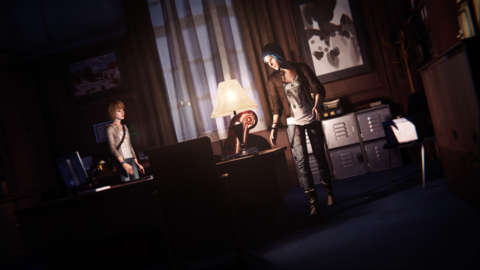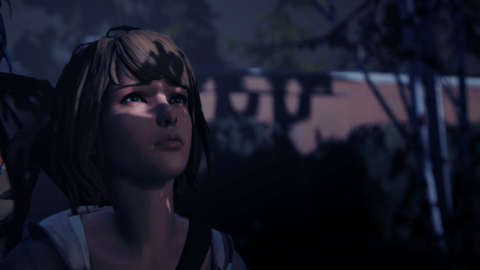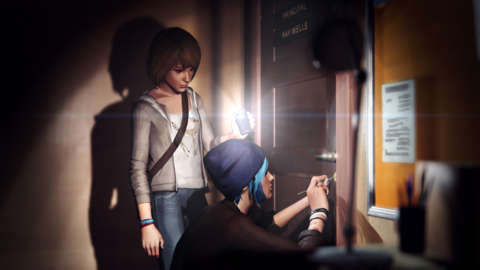With Chaos Theory, its most recent episode, Life is Strange is beginning to straddle the line between the predictable and the unexpected. I felt like I knew what was going on, but after two hours of sifting through puzzles and dialogues, after I was so sure about what was coming next, Life is Strange flipped everything it has established on its head, making me think the next episode will introduce a radically different game.
It's hard to critique what happens in Chaos Theory without spoiling some significant plot points, for both this episode and the previous one, Out of Time. How others interact with protagonist Max Caulfield and what she sees as she wanders Blackwell campus will differ drastically depending on the ending you achieved in Episode Two. The tone is either heartbreakingly somber or surreally uplifting as Max is treated like the town hero. There's a moment where she's allowed to reflect on all that, free from the squiggly hand-written arrows indicating environment objects to interact with, that becomes one of the episode's more poignant moments depending on how patient you are. She either feels lost or invisible, and the intensity of her feelings--the intensity of this moment--brings to light how meaningful the choices you've been making really are.

Until now, you've been guiding Max, with her unexplainable time-rewinding powers, on a quest to find missing girl Rachel Amber and expose the weird conspiracy surrounding Arcadia Bay. At the same time, you're helping her navigate her relationship with Chloe, her troubled childhood best friend. Episode Three makes you question, for the first time in Life is Strange, just how much good Max is actually doing by screwing with time. If you thought Episode Two's ending was harrowing, the latter third of Episode Three is even more devastating. It's a negative emotional payoff, but a strong one worth chasing nonetheless.
Chaos Theory is also where Life is Strange begins to show its Twin Peaks DNA; you can even find the words "fire walk with me" scratched on a mirror in the diner's bathroom. If the Pacific Northwest setting and mystery surrounding a girl and her secrets a la Laura Palmer weren't a tip-off, Max's journey begins to resemble that of Agent Dale Cooper as she struggles to connect the dots between what people are and are not saying. Things are getting weirder and you spend most of the episode talking, rewinding time, and talking again, plumbing cops and fellow students for information on Rachel's disappearance and the town's not-so-secret drug ring.

These intricacies of conversation are interesting, and when you aren't talking, you're exploring. I'm genuinely surprised by the amount of smaller side-actions you can choose to complete in Chaos Theory. As you search for items needed to advance the story, you can stop to look at photos, snoop through laptops, and examine objects, and in some of these cases you can actually alter these objects. For example, you can alter the guest list for an exclusive party or retrieve Chloe's gun. The environment is populated with small pieces of character development, post-it notes and photos that show whom Arcadia Bay's residents really are, and you can spend a sizable chunk of time getting lost examining them all. One fetch quest in Episode Three revolves around David, Chloe's "step-douche," and the mementos of his life Max finds both humanize him and make him frightening in ways previous episode have not.
Life is Strange's strengths lie in littering your path with beautiful scraps of people's lives, but its weaknesses lie in the aforementioned fetch quests. Episode Three uses the same kind of retrieval puzzles that dragged down the momentum of Episode Two: stopping the story to grope in the dark for bomb ingredients or scouring a house top to bottom for eggs can be tedious and breaks the heightened tension of a very well-constructed episode. The solutions to these puzzles may be a little on the obtuse side; in the search for eggs I mentioned above, you find them in a place that is not logical and that doesn't make sense in the context of the scene. These sections still feel out of place and too "gamey" for what developer Dontnod is trying to accomplish emotionally throughout the rest of the episode.
Fetch quests aside, the environmental puzzles in Episode Three make more frequent use of Max's powers. You rewind time to sneak away from teachers and security guards, bypass locked doors, and turn the tables by bullying one of the characters threatening the girls. The time-rewinding mechanic is given a brilliant chance to shine; rather than stuff it into situations so Max can show off or amuse Chloe, it is implemented in smart ways that make it feel like a natural fit. After two episodes of wiring players to think about time travel as an extra tool in their pocket, Chaos Theory is finally using it in both big and small meaningful ways.

As Max gets braver and more confrontational, her relationship with Chloe begins to strengthen. Chaos Theory shows two young women in a radically different relationship than in the first episode. Their reminiscing on the past becomes fonder, their interactions warmer. Life is Strange consistently nails the odd, unexplainable way young women become best friends and how they treat each other; even Chloe's occasional roughness as she attempts to guilt Max for leaving her shows the sincerity of her affection for her old friend. Max is also comfortable calling Chloe out on her more aggressive, rude behavior, but now Chloe is willing to own up to it. These two have grown into their own, and watching them race through a quad holding hands reminded me of those weird, wonderful teenage years with my own best friend. Their relationship is finally blooming, and Dontnod supports this growth with heartfelt dialogue and a handful of very touching scenes between the two.
It's such a shame, then, that Dontnod ruins this tenderness by shoving in a ham-fisted moment suggesting Max and Chloe may be, or become, more than just friends. The moment is fleeting, awkward, jarring, and is only brought up once more in the episode by Max, with no response from Chloe. There is no lead up to this, no fade in or fade out of the moment; it happens, and then goes away.

In some scenes, characters stare at each other with lifeless eyes. There's a scene between Chloe and Max in which the script drops its silly teenager speak and becomes an emotional high point in the pair's relationship arc. It's sweet, and the two say a lot by saying very little. However, while they are talking, they are staring past each other with vacant zombie eyes. This has been present in previous episodes, with some scenes featuring characters that look dead-eyed, but it's in Episode Three that it becomes a real moment-killer.
Beyond the mood-breaking fetch quests and blank stares, however, Life is Strange has finally come into its own in Episode Three, shedding some dialogue and pacing problems from previous episodes. Max takes several big gambles and is now paying her dues, the full potential of her power realized in one terrifying day. Despite her growing bravery, she is becoming exhausted, and Dontnod is doing an excellent job of conveying to you, the player, just how much things are grinding on her. You feel the story's turning point like a knife to the ribs as Chaos Theory comes to a close, and the slow reveal of the potential of Max's powers is surprising and devastating. Max's goals, balancing a personal life and solving a mystery, have finally funneled into the same path, and with the entire story left turned on its head, there's no way to tell where things are going.